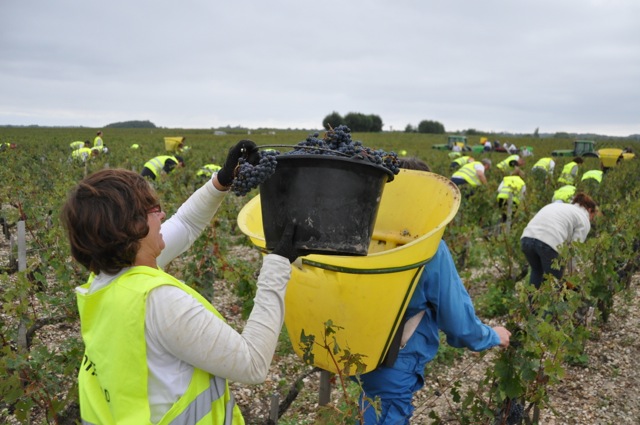Guest blog: Gavin Quinney reports from Bordeaux on an unscheduled start to the harvest for one of the world’s most famous estates, and the severe misfortune that fell on an illustrious neighbour.
"It’s an early vintage, and not an easy one," said Charles Chevallier, the director of Lafite Rothschild, as he checked the Cabernet Sauvignon from their parcel in St-Estephe in his new harvest reception area. He certainly never thought that he’d be bringing in this late-ripening variety exactly one week before the Médoc Marathon, when over 8,000 runners in fancy dress pass through the vineyards on the second Saturday of September. (In 2010, they started picking their Cabernet on 4th October.)
Hail is, in my experience, the wine grower’s worst nightmare. In the space of a few minutes, a healthy crop can be all but wiped out. At 6pm last Thursday, 1st September, with the red harvest just days away, there were several hailstorms across the Bordeaux region. Just up the road from me at Grézillac, near Branne, a few miles south of St-Emilion, hail tore through leaves and blasted grapes in several vineyards. There was then a deluge in Vignonet, closer still to St-Emilion, as the storm continued further east. Mercifully, this was mostly just heavy rain.
On Saturday, I headed over to the Médoc and, from what I’ve seen, a sizeable chunk of St.Estephe – some 900 hectares, apparently – was by far the worst hit. As well as hail, there was an "inondation", with over 70mm of hail and rain falling, compared to barely more than 10mm of rain at the same time in Margaux.
The hailstorm cut a swathe between the vineyards of St-Estephe – "a corridor", witnesses said – with the vines on the gravel mounds leading from Lafon Rochet to Cos Labory and Cos d’Estournel – and beyond to Le Crock, Haut Marbuzet and Montrose – taking the brunt of it. Leaves were shredded and grapes battered.
My swift stroll around the parcels seemed to support this, with the vines on the slopes down to the Gironde estuary having less damage than those on the south and west-facing slopes and plateau. The vines to the north of the chai, or winery, were badly hit. St-Estephe’s other Super Second, Montrose, suffered much less than Cos, but several parcels were hit to a greater or lesser extent before the hail petered out at Meyney. Montrose started picking after the storm, with their large team of imported Spanish workers hard at it on Saturday.
Both the leading St-Estephe estates have seen massive investment of late, with Cos building a new winery and cellars which opened in 2008. Montrose will unveil a new barrel cellar later this year.
Also hit was Lilian Ladouys, where they were busy harvesting by machine over the weekend and de Pez, while Calon Segur and the vines around Phelan Segur, both further north near the village of St-Estephe itself, suffered only superficial damage. Calon Segur was probably spared by the gods because it had been hailed on last year.
In case you were wondering, Lafite has a 4.5 hectare (11 acre) plot in St-Estephe, opposite Lafon Rochet, and they have had a special "derogation" to transform this into Pauillac for many years. The Cabernet Sauvignon from here almost always goes into the Grand Vin – but not this year. At an estimated 50hl/ha, that’s 30,000 bottles that won’t make the cut, the best that Charles Chevallier is hoping for is for the grapes to produce wine of "second-wine" quality.
The fruit was in good condition as it was picked by Lafite’s initial squad of 70 pickers and porters, all sporting yellow safety vests as some of the rows are next to the main road. With the leaves peppered by the hail, and some of the grapes split by the impact, there was no option but to bring it in.

Pickers at Lafite bring in a parcel of Cabernet Sauvignon.
Meanwhile, just across the stream that divides St-Estephe and Pauillac, called La Jalle du Breuil, at least five enormous machines were out on Saturday at Lafite and Duhart Milon next door, spraying an organic "champignon" product on the grapes to combat against the onset of botrytis. Some bunches had suffered a minor impact, and any split grapes could have led to problems with rot.
UPDATE: Read Jeff Leve's interview with Jean Guillaume Prats here.





